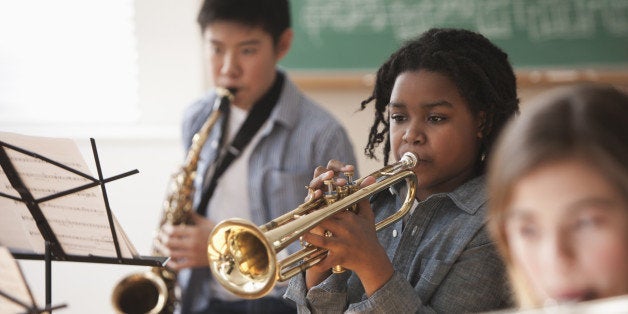
Renaissance High in Detroit, Michigan made the news last month as parents fought to save the highly ranked school's celebrated music program from being terminated. It was only the latest in a long line of communities facing similar cuts from Chicago, Illinois to Manchester, Connecticut.
Detroit parent L'Tanya Toliver best explained the concerns of residents in all of these communities:
We want the opportunity to let our children have band, we want our children to have dance, we want our children to get the fulfillment of the education that they should get, that they deserve.
Toliver's words resonate with many across the country facing similar issues. While budgetary cuts across the board negatively impact schools, in most cases they decimated programs in music and the arts, robbing students of the intellectual, cognitive, and social benefits of these pursuits. Such needs, of course, are most acute in urban school districts like Detroit, Chicago, Philadelphia, Los Angles and Memphis.
Budget cuts to art and music programs also harmed communities in ways not always readily apparent. At an earlier time, it would have been difficult, if not impossible, to drive through any community without passing one of the gigantic, student-created displays for the local middle school play or attending some parade or festival unaccompanied by the pulsating rhythms of the high school band.
This is not simply nostalgia. Real teaching and learning take place for the students involved in these activities -- not to mention real benefits to communities. Art shows, recitals and theatrical performances of all kinds are meaningful exhibitions of knowledge and the application of acquired skills taking place where everyone can see and enjoy them in public spaces. The often-overlooked teachers who train and prepare them are masters of their craft. Classifying what they teach as "soft skills" is insulting as well as shortsighted.
The intangible benefits of public education will never appear in the sterile strips of data represented by tests scores. The high school band members who play in churches, parks, parades and festivals, the young thespians and dancers who share their talents in shows, and the artists who paint murals on the sides of buildings bring a splash of life and color to an otherwise desolate urban landscape -- they put the public into public education.
Art and music also convey important skills that often are overlooked. Researchers have long touted their positive effects on student brain growth and development, but the exercise of those skills in artistic pursuits like band and chorus adds a whole new dimension of teamwork, perseverance, and commitment. Additionally, students actually learn and exercise all of the 21st century skills so-called corporate education reformers claim are essential to employers. From set design and orchestration, to staging and improvisation, music, drama, and art are a collective smorgasbord of practical application.
The arts impart practical employable skills from project management, team building, and effective time administration, to leadership, cooperation and collaboration. And yet, the deliberate targeting of these programs and willful mischaracterization of them as secondary to STEM (Science, Technology, Engineering, and Mathematics) robs not only students, but also parents and communities of one of the most honest, public measures of student achievement and success.
Anyone who has ever had the opportunity to watch students assemble a set knows the intricate mix of math and creativity that pepper such activity. It is the wedding of skill and imagination in the service of something tangible -- with authentic deadlines and impact. The fruit of their study is the performance or exhibition itself, a genuine measure of whether they have achieved a degree of proficiency or mastery. Such tests are not conducted in sterile environments--with abstruse answers shaded into tiny bubbles with number 2 pencils, but on stages, platforms and galleries using actual instruments including their own bodies to demonstrate achievement. The philosopher Aristotle once observed, "The aim of art is to represent not the outward appearance of things, but their inward significance." In this way, the arts are yet another means by which students can find a means of personal expression. These are powerful displays of student growth that affirm civic values and allow students not only to demonstrate what they have learned but also to share it in ways that enrich not only the individual but also the community as a whole.
